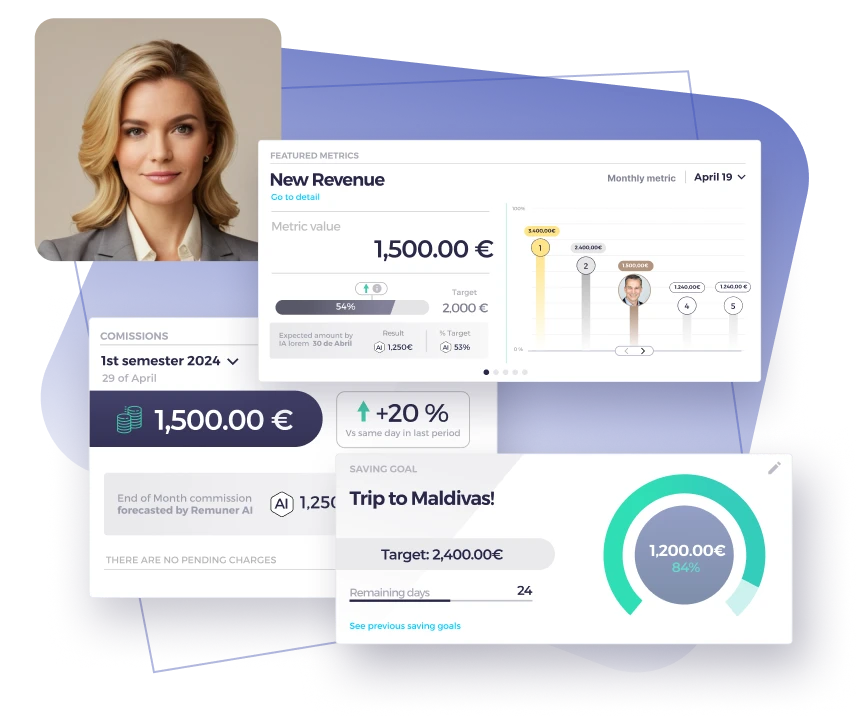Table of contents
Churn rate measures how many customers leave your business within a certain period. Keeping churn rate low ensures your customer base stays strong and stable, positively impacting your revenue growth.
In this article, we’ll explore in detail what churn rate is, how you can calculate it, why it matters, and how to effectively reduce it. We’ll also include practical examples and offer best practices, including how platforms like Remuner can align your sales incentives and compensation plans to help lower churn.
What Is Churn Rate?
Churn rate, also known as customer churn rate or customer attrition, represents the percentage of existing customers who leave or stop using your services during a specific period. It directly shows customer dissatisfaction or the effectiveness of your retention strategies.
Businesses typically measure it monthly or annually. It’s especially critical for subscription-based companies and businesses that rely heavily on repeat customers. A high churn rate can negatively affect your business model by increasing customer acquisition costs and reducing overall profitability.
Examples of churn rate in action
Let’s look at a practical example:
Imagine a subscription-based SaaS company begins the month with a total customer base of 500 customers. During that month, the company loses 25 customers. To calculate churn rate:
Churn Rate = (Lost Customers / Total Customers at Start) × 100
Churn Rate = (25 / 500) × 100 = 5%
This 5% monthly churn means the company needs effective strategies to retain customers, ensuring the sustainability of its business model.
How to calculate churn rate
Calculating churn rate is straightforward. The basic formula is:
Churn Rate (%) = (Lost Customers ÷ Total Customers at the Start) × 100
You can calculate churn rate in different ways:
Customer churn rate example:
- If your business had 1,000 customers at the beginning of the month and lost 40 customers by the end, your monthly churn rate is: (40 ÷ 1,000) × 100 = 4%
Revenue churn rate example:
Revenue churn rate measures the loss of monthly recurring revenue (MRR) due to customer churn. Suppose your business generates €20,000 MRR at the start of the month and loses €1,000 due to customer cancellations or downgrades:
Revenue Churn Rate = (€1,000 ÷ €20,000) × 100 = 5%
Monitoring revenue churn rate alongside customer churn rate provides better insights into your financial health and customer retention strategies.
Why Churn Rate Matters: 4 Key Reasons
Understanding churn rate helps your business identify areas that require attention and investment. A high rate of it means you’re losing customers faster than acquiring them, negatively affecting long-term growth and profitability.
Key reasons why is important:
- Cost Efficiency: Acquiring new customers typically costs significantly more than retaining existing ones.
- Customer Lifetime Value: A lower churn rate increases customer lifetime value, enhancing your overall profitability.
- Market Competitiveness: Maintaining loyal customers helps your business remain competitive and resilient in your industry.
- Revenue Predictability: Businesses with low churn rates experience more predictable revenue growth and stability.
Not all churn is equal. Harvard Business School’s churn profitability study found that selectively allowing low-value customers to churn can increase profits by 25% while maintaining revenue growth.
It impacts your sales team’s performance directly, influencing their ability to hit their quota and achieve their on-target earnings (OTE). Businesses should consider churn rates when designing sales incentives and compensation structures, such as those managed effectively through platforms like Remuner.
What is a good churn rate?
A good churn rate varies significantly depending on your industry, business model, and customer expectations. However, general benchmarks can guide your evaluations:
- Subscription-based businesses: Average churn rates typically range from 5% to 7% annually.
- SaaS Companies: A healthy average churn rate often falls below 5% annually.
- Telecommunications and Utilities: Typically experience higher churn rates, around 10% to 20% annually.
Aim to consistently reduce your churn rate below your industry average, creating stability and predictable growth for your business.
How It Impacts Sales Performance
Churn rate directly impacts your sales team’s ability to achieve sales performance goals. A high rate indicates sales incentives might focus excessively on customer acquisition rather than customer retention.
Effective compensation plans should include incentives for retaining customers, not just acquiring new ones. Platforms like Remuner allow businesses to build balanced sales compensation plans aligning sales incentives with long-term retention goals, helping sales reps consistently achieve quotas and OTE.
For example, a sales compensation structure could reward your sales team for reducing churn or maintaining customer retention rates above specific thresholds. This motivates sales reps to pursue quality, long-term customer relationships rather than merely closing new deals.
5 Strategies to reduce churn rate effectively
Reducing churn rate requires a strategic approach that includes customer satisfaction, retention incentives, and proactive customer management. Here are effective strategies:
1. Improve onboarding and customer education
Ensuring customers clearly understand how your product or service works and how it benefits them reduces early-stage churn. Comprehensive onboarding helps customers see immediate value, improving long-term retention.
2. Offer proactive customer support
Identify at-risk customers early by monitoring usage patterns and providing proactive support. Reach out to customers before dissatisfaction escalates into cancellation.
3. Create loyalty programs and incentives
Reward customers for continued loyalty, offering discounts, exclusive features, or special recognition. This strengthens customer relationships and reduces attrition.
4. Personalize your customer engagement
Engage customers regularly with personalized offers based on their interests, behaviors, or usage patterns. Personalization fosters emotional connections, encouraging customer retention.
5. Align sales incentives with customer retention
Adjust compensation structures and sales incentives to prioritize customer lifetime value. Tools like Remuner make designing these compensation structures easier, ensuring your sales team’s incentives align with reducing churn.
How Remuner helps reduce churn through better sales incentives
Remuner provides a powerful platform to manage and optimize your sales incentives and compensation plans, aligning them directly with customer retention objectives. Using Remuner, businesses can:
- Create compensation plans rewarding sales reps for customer retention and reducing churn rates.
- Automate commission calculations and provide real-time visibility into sales performance.
- Ensure transparency in quotas, OTE calculations, and compensation structures, improving overall sales team motivation and customer retention.
Explore how Remuner can help your business reduce churn and drive better sales performance by booking a demo today.
FAQs
What exactly is churn rate?
Churn rate is the percentage of your total customers who leave or stop doing business with you within a specific time period.
How often should businesses calculate churn rate?
Most businesses calculate it monthly or quarterly. Subscription-based companies often monitor it monthly to swiftly respond to issues.
What causes high churn rates?
High churn often stems from poor customer service, dissatisfaction with product quality, better competitor offerings, or inadequate onboarding processes.
Can churn rate be negative?
Yes. Negative churn occurs when revenue gained from existing customers (upselling or cross-selling) surpasses lost revenue from churned customers, indicating healthy growth.
Why is reducing churn rate critical for sales teams?
Reducing churn helps sales teams meet quotas more consistently, achieve their OTE targets, and maintain stable and predictable revenue growth.
Conclusion
Understanding what churn rate is, why it matters, and how to calculate and reduce it is vital for sustainable business growth. By aligning your sales incentives and compensation strategies to focus on customer retention and leveraging tools like Remuner, businesses can significantly reduce churn, improve sales performance, and enhance long-term profitability.
Ready to optimize your sales compensation and reduce churn rate? Discover how Remuner can align your sales incentives to enhance customer retention and profitability.





